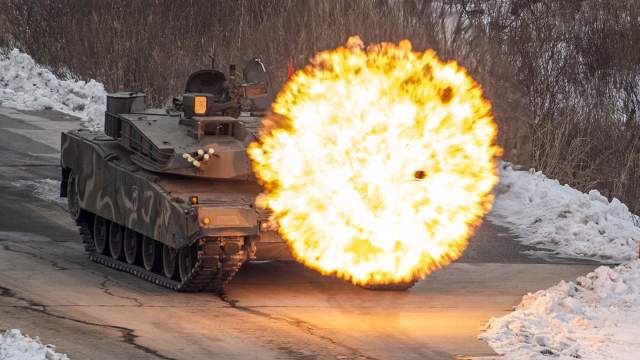While North Korea is demonstrating intercontinental munitions with nuclear charges, Seoul is conducting military maneuvers
North Korea today possesses missile systems that are comparable in their capabilities to the nuclear weapons of the leading world powers. The DPRK's ammunition is capable of hitting targets not only in the Pacific Ocean, but also in any part of the main territory of the United States. 2024 began with another escalation of mutual threats on the Korean peninsula. Izvestia, together with military expert Dmitry Kornev, founder of the Military Russia portal, looked into how real North Korea's missile power is and what South Korea can oppose to it.
On the verge of confrontation
The exchange of artillery strikes has so far ended in nothing. There was no escalation into war, and the parties limited themselves to demonstrative shelling of marine areas. The first — on January 5 — 200 shells were fired by the North Korean military. The strike was carried out on the coastal area of the Yellow Sea near the disputed islands, which are under the jurisdiction of South Korea. The Seoul military responded symmetrically on the same day — 400 shells at a point north of the conditional demarcation line in the Yellow Sea. The strike was carried out from the Kaemori base and Cape Changsan, and after such a response, reports appeared in the media about the highest degree of tension between the two countries.
On January 7, the sister of North Korean leader Kim Yo Jong told the Korean Central Telegraph Agency (KCNA): "Our army has already taken the safety off the trigger. In the event of even a minor provocation, our troops will immediately undergo a baptism of fire." The extremely tense situation persists, and a persistent feeling is created that it is enough to bring a match to ignite the fire of a new war.
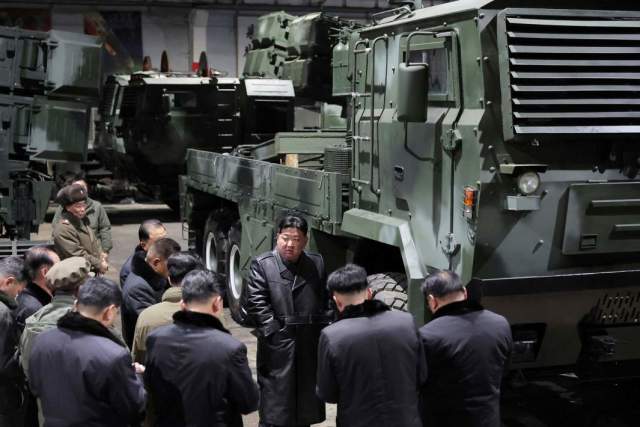
North Korean leader Kim Jong-un visits an ammunition factory
Image source: Photo: REUTERS/KCNA
But is war with a nuclear-armed North Korea possible? The fact that the DPRK today possesses missile systems that are comparable in their capabilities to the nuclear weapons of the leading world powers was demonstrated once again on January 5, 2024 during Kim Jong-un's visit to the plant for the production of self-propelled launchers of intercontinental ballistic missiles.
KCNA writes: "Dear Comrade Kim Jong-un was in charge of the affairs of the main factory for the production of military launch vehicles on the spot." Judging by the agency's report, the head of the DPRK inspected the finished goods workshop and the assembly plant of the Hwasong-17 and Hwasong-18 missile launchers. These are the most powerful ballistic missiles of modern North Korea, which can carry nuclear charges to the United States.
With the Soviet reserve
The Hwasong-17 is a heavy liquid—fuel intercontinental missile, which was created using Soviet technologies, among other things. It has a mass of about 100 tons and can carry a megaton-class warhead to a range of up to 15 thousand km. A heavy multiaxial conveyor takes the product to the launch position and lifts it to the launch table. After that, aiming and launching are performed. All this takes a certain amount of time — unlike Russian mobile missile systems, where aiming is performed before the rocket is lifted and launched.
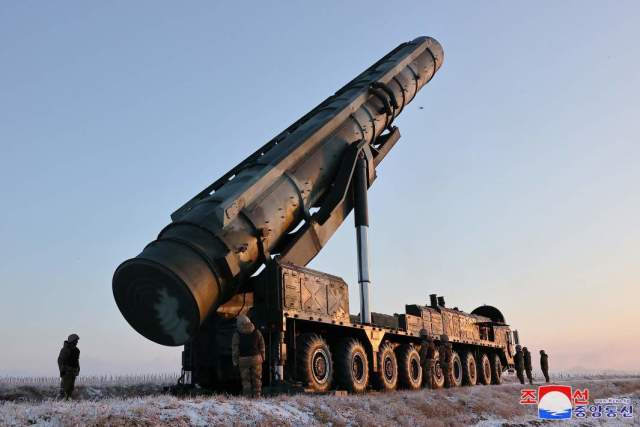
The Hwasong-18 intercontinental ballistic missile
Image source: Photo: REUTERS/KCNA
The difference in technology is determined by an understandable lag — if multi-axle rocket-carrying vehicles had been created in the 1960s, then it is likely that our first mobile missiles would also have been liquid-fueled Chelomey and Yangel design bureaus. But history has taken a different path — along the path of placing lighter solid-fuel missiles on mobile carriers.
North Korean rocket scientists have also taken this path — the Hwasong-18 has already become a solid-fuel intercontinental missile that launches from a transport and launch container and is close in size to Russian developments such as Topol-M and Yars. Even the appearance of the launchers of the North Korean comrades is similar to our mobile ground-based missile systems (PGRCS). And this is also not accidental — the Chinese chassis used in North Korea's launchers are based on Minsk multi—axle tractors. Apparently, it was Belarusian specialists who transferred this technology to the Celestial Empire.
North Korean leader Kim Jong-un watches the launch of the Hwasong-18 intercontinental ballistic missile
Image source: Photo: REUTERS/KCNA
According to experts, the Hwasong-18 has a mass of about 55-60 tons and a flight range of about 15 thousand km. It can probably even carry several light or medium—power warheads - more than 150 kilotons each. This is comparable to the capabilities of our Yars complexes — a fairly serious threat to any country that Hwasong can reach. The No. 1 target in North Korea, of course, is called the United States.
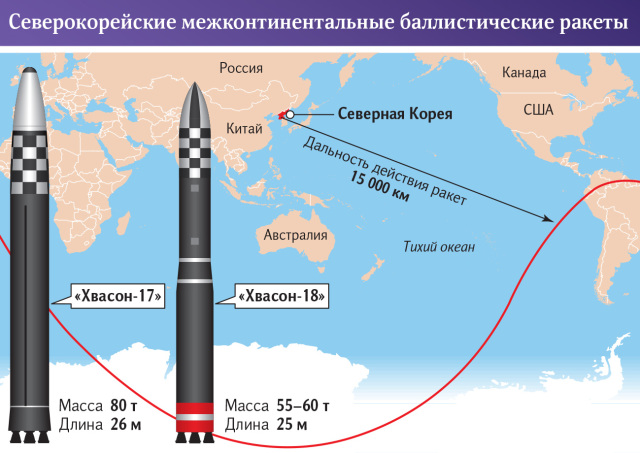
How real is the threat
How many missiles of this type does the DPRK have? There is no open data on the DPRK's nuclear arsenal. The production of launchers was openly shown for the first time. It was demonstrated to the world that at least four to six Hwasong-17 ICBM launchers and at least seven Hwasong-18 ICBM launchers are located at the plant.
It can also be assumed that after the creation of more efficient solid-fuel missiles, work on the heavy and bulky Hwasong-17 can be curtailed. That would be logical. Plus, North Korea showed several cabins of rocket carriers that are being prepared for installation. That is, at least a dozen modern and mobile Hwasong-18 missiles may be at the disposal of the DPRK's nuclear forces. This is a very serious threat to the United States, as these munitions are capable of hitting not only targets in the Pacific Ocean, but also in any part of the main territory of the United States.
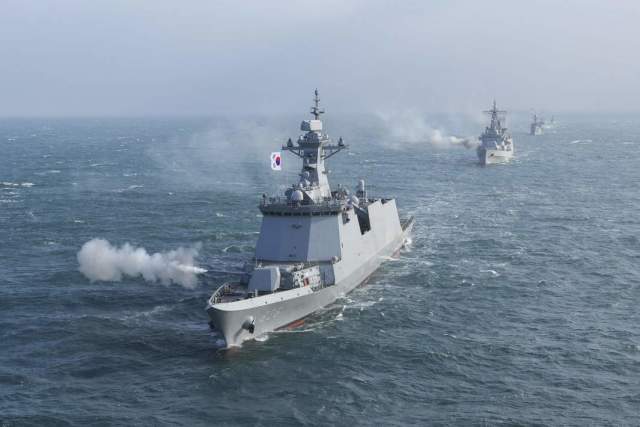
South Korean live-fire exercises in the West Sea
Image source: Photo: Global Look Press/Rok Navy
Of course, the United States has certain missile defense capabilities. The fleet is equipped with Aegis systems. There are also ground-based mobile missile defense systems. But the risk is too great that it will not be possible to block all the options for the trajectories of a potential missile strike — it is almost impossible to predict them. And therefore, the United States will rely on preventing such a strike with the deployment of hypersonic missile systems and air strike assets in South Korea and near it during the threatened period of time in order to destroy North Korean heavy missiles that have advanced to launch positions before launch.
There is another way to prevent a nuclear catastrophe, and it still looks more reliable — it is to reduce the degree of confrontation. Apparently, this is exactly the path taken by the American military and their South Korean partners. Moreover, if it breaks out, then if something reaches America, it will not destroy the United States, but several dozen tactical nuclear warheads of the DPRK will be able to wipe off the face of the earth in the event of a military escalation. And it is difficult to oppose this nuclear retaliation in principle.
Dmitry Kornev
